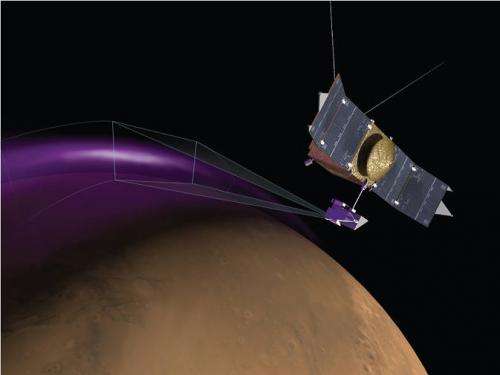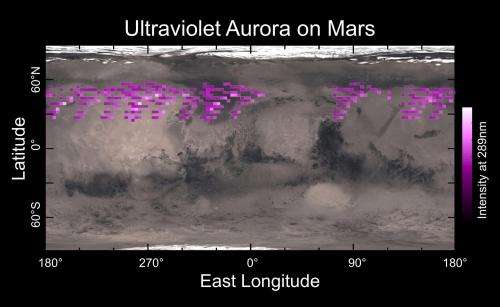Dust cloud, aurora detected around Mars

A NASA spacecraft circling Mars has detected a mysterious dust cloud and a vibrant aurora, both unexpected phenomena on Earth's neighboring planet, researchers said Wednesday.
NASA's Mars Atmosphere and Volatile Evolution (MAVEN) detected the aurora—known on Earth as the Northern lights—in December, so they were nicknamed "Christmas Lights," according to a statement issued by NASA on the same day as the findings were presented at a Texas astronomy conference.
"For five days just before December 25, MAVEN saw a bright ultraviolet auroral glow spanning Mars' northern hemisphere," it said.
Aurora are seen when geomagnetic storms unleashed by eruptions on the Sun cause energetic particles like electrons to crash into the atmosphere, causing the gas to glow.
"What's especially surprising about the aurora we saw is how deep in the atmosphere it occurs—much deeper than at Earth or elsewhere on Mars," said Arnaud Stiepen, Imaging Ultraviolet Spectograph team member at the University of Colorado.
"The electrons producing it must be really energetic."
Experts believe the source of the energetic particles for the Mars aurora is the Sun, because MAVEN's Solar Energetic Particle instrument "detected a huge surge in energetic electrons at the onset of the aurora," NASA said.
Since Mars lost its protective magnetic field billions of years ago, the solar particles can directly strike the atmosphere and penetrate deeply.

Scientists also observed an unusual dust cloud, with the help of MAVEN, about 93 miles (150 kilometers) above the Red Planet's surface.
The source of the dust, its contents, and whether it is temporary or permanent, are all unknown.
"Possible sources for the observed dust include dust wafted up from the atmosphere; dust coming from Phobos and Deimos, the two moons of Mars; dust moving in the solar wind away from the Sun; or debris orbiting the Sun from comets," NASA said.
"However, no known process on Mars can explain the appearance of dust in the observed locations from any of these sources."
The findings were presented at the 46th Lunar and Planetary Science Conference in The Woodlands, Texas.
MAVEN launched toward Mars in November 2013, on a mission to study how the planet lost most of its water and atmosphere.
The unmanned orbiter is four months into its one-year mission.
© 2015 AFP





















